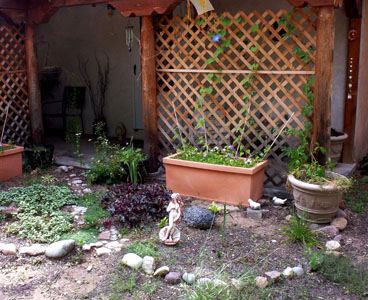|
 For
me, gardening, whatever its other rewards, is an
esthetic experience. When I was young, I followed
the practical advice in vegetable gardening books
and planted things in orderly rows, like a small
farm. This was even how I treated my irises, when I
grew them by the hundreds for showing and
breeding. For
me, gardening, whatever its other rewards, is an
esthetic experience. When I was young, I followed
the practical advice in vegetable gardening books
and planted things in orderly rows, like a small
farm. This was even how I treated my irises, when I
grew them by the hundreds for showing and
breeding.
But
I became increasingly enamored of the
beautiful outdoor spaces that some of my friends
created with their gardens. Swirling drifts of
flowers, dark green lawns, old trees providing a
calm and cool microclimate, sheltering us from the
summer sun.
A garden is
always, to some degree, an unnatural place, and
artifact of human design. No garden is the same as
wild nature. But there are many different ways and
degrees by which the stamp of human contrivance can
appear in a garden. Through much of history,
gardens were not intended to echo or emulate nature
at all. Garden design followed the sensibilities of
archetecture, and plants that failed to comform to
the specifications and expectations of the designer
were avoided. The formal gardens of Europe, for
example, are certainly great works of art, but they
sometimes leave me wondering whether marble and
iron might not have answered the designer's needs
more dutifully than living things.
During the
Romantic period, a new appreciation of the natural
world percolated up in Europe, and people began
designing gardens with an esthetic that paid homage
to natural spaces. Paths drifted sinuously between
trees, flowers sprung up in drifts as though
scattered there by Nature's hand. Increased
exposure to Japanese gardens and their more fluid
esthetic also left a great impact on 20th century
gardens in Europe and the US.
I feel
that nature has its own esthetic, which we see in
the design of individual plants, and in the
interpenetration of different species in the wild.
In the garden, this esthetic comes into
conversation with my own human artistic
sensibilities. The gardens I like best now are ones
where neither party completely dominates the
conversation. We too, are natural creatures, though
we are prone to forget that. We can bring into play
the elements we enjoy: color, line, and form -
without silencing the natural ways of the plants we
grow or forcing them into preconceived roles.
Plants that find their niche in a garden are always
beautiful and healthy. When a plant makes such a
choice to belong where it is, it becomes something
I work with, changing my designs as I go.
Nothing
fascinates me quite as much as old, overgrown
gardens, that still receive some love from their
human custodians. They are conversations matured
into shared reminiscences. The groundcovers still
remember the flagstones when they were first set,
but now have added their own voice, creating a
collaborative performance. The tree that was once a
young sapling now dominates a space never designed
for it, so the space has changed - no longer an
exuberant flower bed, but a quite enclave of
shade-lover plants and the creatures that enjoy
them.
If your
garden is not a hundred years old, you can still
partake of this esthetic of give-and-take. Here are
some guidelines I use to create more
naturalistic garden spaces:
- Keep
outlines soft, marking boundaries with stones or
other natural elements, rather than fences or
rigid edging.
- Let the
plants expand and move as they
choose
- Place
artificial elements with a little randomness
(not too much, or they will look
incongruous)
- Avoid
using straight lines
- Intermingle
perennials and annuals; plant the perennials in
key locations, and fill in with annuals between
them
- Intermingle
flowers, herbs, and vegetables
- Intermingle
walkways and ground covers
- Place
sprawling plants near boundaries, where their
growth break up the appearance of the
edge
- Allow
your garden plants to coexist with native
plants
Your garden
can express your personality, and yet become
something more, with the passage of a little time
and a willingness to listen to the plants'
suggestions.
|